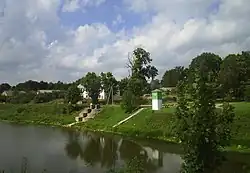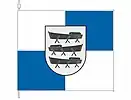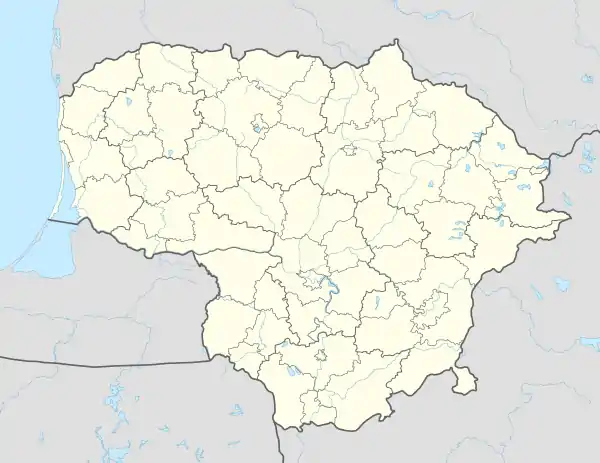Smalininkai | |
|---|---|
City | |
 Piers on the Nemunas River in Smalininkai | |
 Flag  Coat of arms | |
| Nickname: Smolnis | |
 Smalininkai Location of Smalininkai | |
| Coordinates: 55°5′0″N 22°34′0″E / 55.08333°N 22.56667°E | |
| Country | |
| Ethnographic region | Lithuania Minor |
| County | Tauragė County |
| Municipality | Jurbarkas District Municipality |
| Eldership | Smalininkai eldership |
| Capital of | Smalininkai eldership |
| First mentioned | 15th century |
| Granted city rights | 1945 |
| Population (2021) | |
| • Total | 862 |
| Time zone | UTC+2 (EET) |
| • Summer (DST) | UTC+3 (EEST) |
Smalininkai (ⓘ; German: Schmalleningken; Polish: Smolniki[1]) is a small city in Lithuania. It is located on the right bank of the Neman River, 12 km (7.5 mi) west from Jurbarkas, in the region of Lithuania Minor.
Name
The name describes a place of tar and pitch burners ("smala": tar, pitch; -ingken: village).
History
Since 1422 Treaty of Melno, it was a border village at the Lithuanian-Teutonic customs frontier. In 1454, King Casimir IV Jagiellon incorporated the region to the Kingdom of Poland upon the request of the anti-Teutonic Prussian Confederation.[2] After the subsequent Thirteen Years' War (1454–1466) the village was a part of Poland as a fief held by the Teutonic Knights,[3] and thus was located within the Polish–Lithuanian union, later elevated into the Polish–Lithuanian Commonwealth. From the 18th century, it was part of the Kingdom of Prussia, and from 1871 it was also part of Germany, within which it was administratively located in the province of East Prussia. In 1792 it was appointed to a market town. In 1845 the village became a parish and 1878 a church was built there. In the late 19th century, the village had a population of 709, which was mostly employed in agriculture, shipping and timber trade.[4] Large quantities of spirit were sold to Russia, while Polish rafters bought wooden pipes here.[4] In 1902 a light railway was built from Pogegen (Pagėgiai) to Schmalleningken (Smalininkai). Following World War I, in 1918, Lithuania regained independence, and in 1923 eventually obtained the region. In 1925, the village had 1,741 inhabitants. In 1939, it was annexed by Nazi Germany and incorporated into the Landkreis Tilsit-Ragnit (district). The German occupation lasted until the end of World War II in 1945.
References
- ↑ Słownik geograficzny Królestwa Polskiego i innych krajów słowiańskich, Tom X (in Polish). Warszawa. 1889. p. 912.
{{cite book}}: CS1 maint: location missing publisher (link) - ↑ Górski, Karol (1949). Związek Pruski i poddanie się Prus Polsce: zbiór tekstów źródłowych (in Polish). Poznań: Instytut Zachodni. p. 54.
- ↑ Górski, pp. 96–97, 214–215
- 1 2 Słownik geograficzny Królestwa Polskiego i innych krajów słowiańskich, Tom X (in Polish). Warszawa. 1889. p. 379.
{{cite book}}: CS1 maint: location missing publisher (link)
Literature
- Kurschat, Heinrich A.: Das Buch vom Memelland, Siebert Oldenburg 1968
